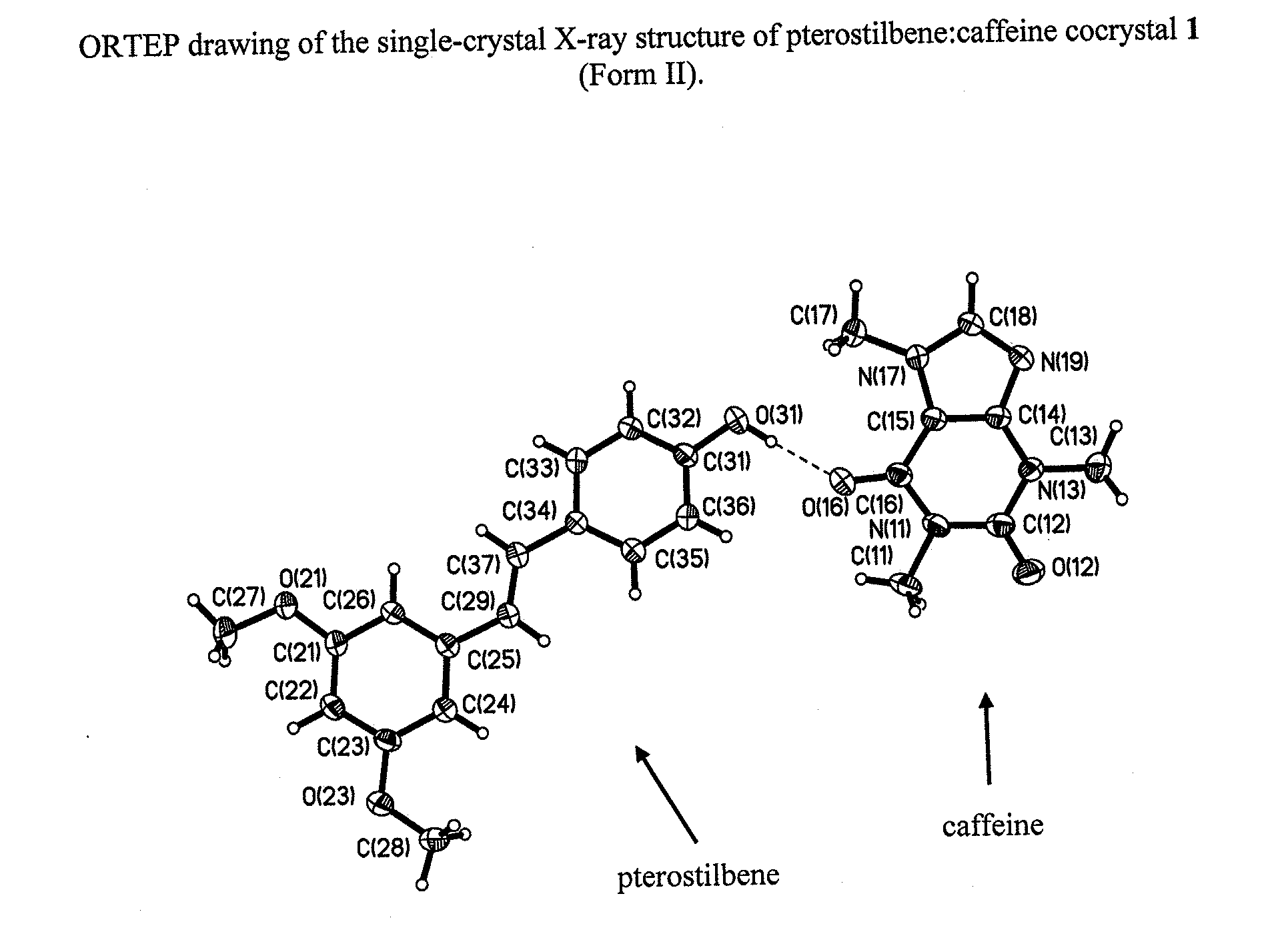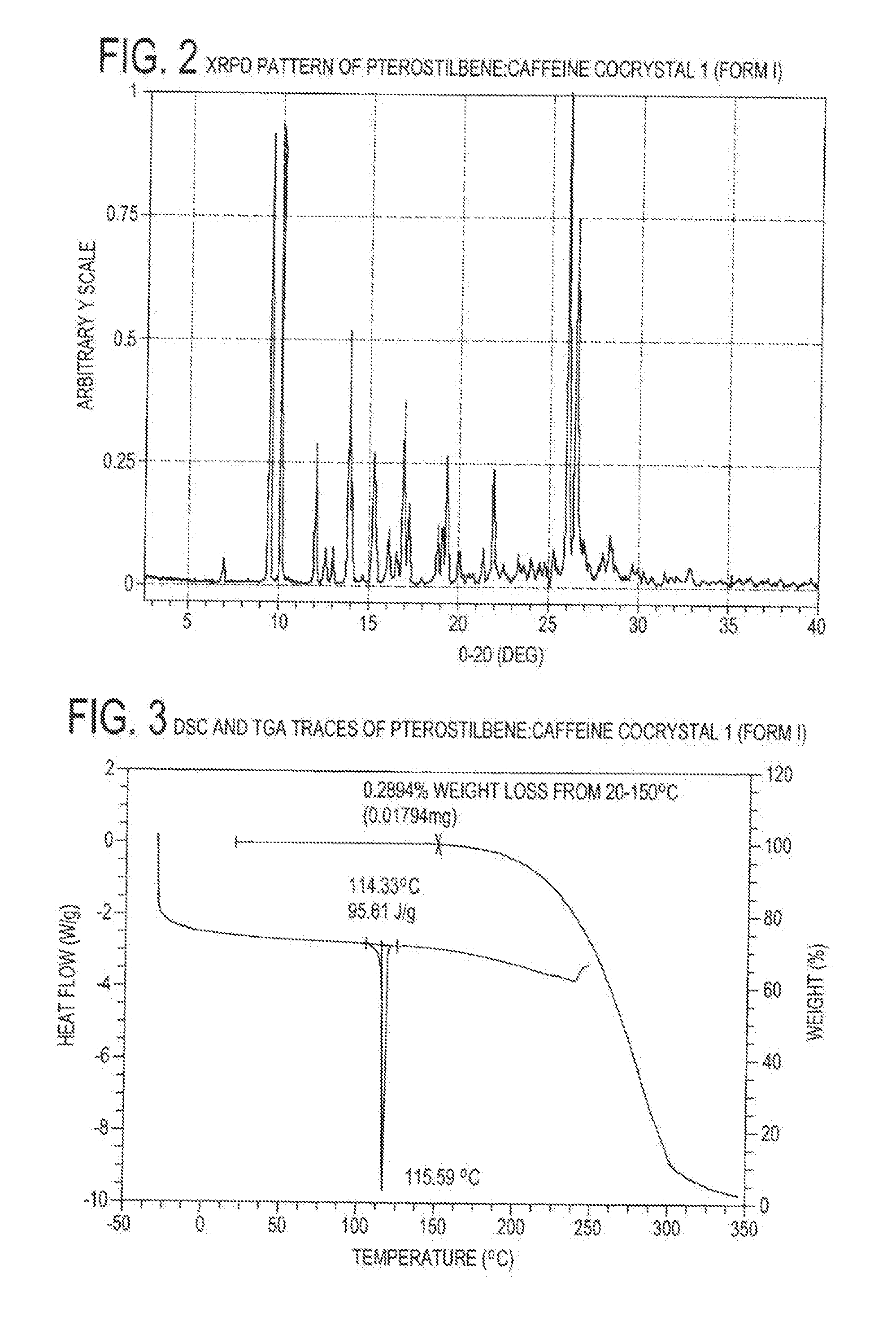Pterostilbene cocrystals
a cocrystal and pterostilbene technology, applied in the field of new crystalline compounds containing pterostilbene, can solve the problems of poor solubility in water, lack of investigation of solid-state behavior of pterostilbene, and lack of solid-state properties to date, and achieve the effect of physical stability of the cocrystal
- Summary
- Abstract
- Description
- Claims
- Application Information
AI Technical Summary
Benefits of technology
Problems solved by technology
Method used
Image
Examples
example 1
Preparation of 1:1 Pterostilbene:Caffeine Cocrystal, 1 (Form I)
[0084]Cocrystal 1 (Form 1) was prepared by a grinding method and solvent-based methods. For grinding, a 1:1 mixture of pterostilbene (˜45 mg, ˜0.18 mmol) and caffeine (˜34 mg, ˜0.18 mmol) were added to a milling jar. Approximately 25 μL of solvent (chloroform, acetonitrile, ethanol, or nitromethane) were added and the material was ground for 20 minutes at a rate of 30 Hz. For the solvent-based methods at ambient temperature, solid caffeine was added to a nearly saturated solution of pterostilbene in ethanol and allowed to stir for ˜24 hours before filtering. Single crystals were grown from a vapor diffusion experiment where a 1:1 mixture of pterostilbene (56.0 mg, 0.22 mmol) and caffeine (42.4 mg, 0.22 mmol) was dissolved in a minimal amount of methanol (2 ml) in a 1 dram vial. The 1 dram vial was placed uncapped in a 20 ml vial containing water. The larger vial was capped, and after 2 days, rod-shaped crystals were harv...
example 2
Preparation of 1:1 Pterostilbene:Caffeine Cocrystal, 1 (Form II)
[0085]Single crystals were grown from a vapor diffusion experiment where a 1:1 mixture of pterostilbene (˜56.0 mg, ˜0.22 mmol) and caffeine (˜42.0 mg, ˜0.22 mmol) was dissolved in a minimal amount of methanol (2 ml) in a 1 dram vial. The 1 dram vial was placed uncapped in a 20 ml vial containing water. The larger vial was capped, and after 2 days colorless, prism-shaped crystals were harvested.
example 3
Preparation of 1:1 Pterostilbene:Carbamazepine Cocrystal, 2
[0086]Cocrystal 2 was prepared by a grinding method and solvent-based methods. For grinding, a 1:1 mixture of pterostilbene (˜41 mg, ˜0.16 mmol) and carbamazepine (˜38 mg, ˜0.16 mmol) was added to a milling jar. Approximately 25 μL of solvent (chloroform, acetonitrile, ethanol, or p-dioxane) were added and the material was ground for 20 minutes at a rate of 30 Hz. The cocrystal was scaled up using solvent-based methods at ambient temperature, where solid carbamazepine was added to a nearly saturated solution of pterostilbene in toluene and allowed to stir for ˜24 hours before filtering. Single crystals were grown from a vapor diffusion experiment where a 1:1 mixture of pterostilbene (55.3 mg, 0.22 mmol) and carbamazepine (50.8 mg, 0.22 mmol) was dissolved in a minimal amount of methanol (2 ml) in a 1 dram vial. The 1 dram vial was placed uncapped in a 20 ml vial containing water. The larger vial was capped, and after 2 days,...
PUM
| Property | Measurement | Unit |
|---|---|---|
| melting point | aaaaa | aaaaa |
| melting point | aaaaa | aaaaa |
| melting point | aaaaa | aaaaa |
Abstract
Description
Claims
Application Information
 Login to View More
Login to View More - R&D
- Intellectual Property
- Life Sciences
- Materials
- Tech Scout
- Unparalleled Data Quality
- Higher Quality Content
- 60% Fewer Hallucinations
Browse by: Latest US Patents, China's latest patents, Technical Efficacy Thesaurus, Application Domain, Technology Topic, Popular Technical Reports.
© 2025 PatSnap. All rights reserved.Legal|Privacy policy|Modern Slavery Act Transparency Statement|Sitemap|About US| Contact US: help@patsnap.com



